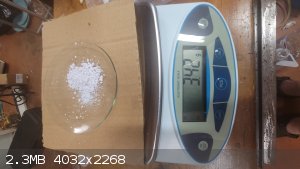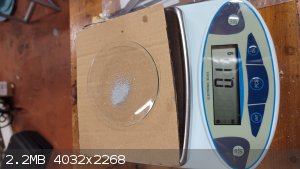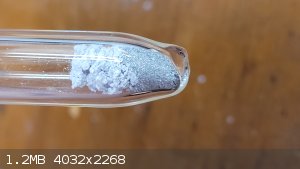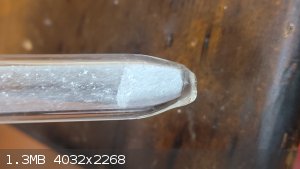| Pages:
1
2
3
4 |
Rainwater
National Hazard
   
Posts: 919
Registered: 22-12-2021
Member Is Offline
Mood: indisposition to activity
|
|
Smoking a bird board and half lit wishing i had packed some tubes and a retort
Somewhere it was asked what other salts could be used
Heres some thermodynamics values. Took longer to format this table than to do the math
| Code: |
Name ΔG ΔH ΔS ΔG = 0 when T =
AuCl3 -557.97 -466.90 333.38 -1673.66 C
BCl -941.25 -1033 -335.85 2802.59 C
BCl3 -180.69 -157.32 85.56 -2111.78 C
BrCl -317.57 -292.78 90.73 -3500.13 C
CdCl2 -100.46 3.72 381.41 -263.39 C
CoCl2 -322.77 -231.38 334.59 -964.66 C
CrCl2 -63.94 17.15 296.88 -215.37 C
CuCl2 -646.28 -551.45 347.18 -1861.5 C
FeCl2 -225.57 -143.64 299.95 -752.02 C
FeCl3 -231.73 -185.02 171.00 -1355.12 C
HCl -286.00 -308.00 -78.00 3647.0
HgCl2 -595.09 -496.22 361.96 -1644.09 C
MnCl2 189 275 313 604.24 C
NH4Cl 8.71 220.00 775.00 11.2
NiCl2 -353.70 -253.01 368.61 -959.55 C
PbCl2 -188.67 -90.79 358.32 -526.54 C
S2Cl2 -804.76 -723.41 297.82 -2702.2 C
SnCl4 -946.98 -804.16 522.83 -1811.24 C
ZnCl2 -25.39 76.15 371.75 -68.31 C
|
EDIT:
I edited the list of all the compounds that wouldn't provide a negative delta g with a temp less than 1000c
Looks like the reactions that have reported low yields or difficulty in reproduceling are endothermic.
[Edited on 24-11-2022 by Rainwater]
"You can't do that" - challenge accepted
|
|
|
blogfast25
International Hazard
    
Posts: 10562
Registered: 3-2-2008
Location: Neverland
Member Is Offline
Mood: No Mood
|
|
Thanks for these values.
Have you taken into account the entropic effect of AlCl3(g)?
[Edited on 24-11-2022 by blogfast25]
|
|
|
Rainwater
National Hazard
   
Posts: 919
Registered: 22-12-2021
Member Is Offline
Mood: indisposition to activity
|
|
I am not sure what that is so I'm gonna say no.
When I was first reading this thread, not understanding the difficulty in creating the product, it lead to some nice googling, lots of concepts in
play.
Those values were generated using the formula ΔG = ΔH - TΔS
Thermodynamic values are from here
The listed values were from reagents, anhydrous, in solid state unless data for solids was not available, at 1 atm, 0c. (Probley got the state wrong
for some of those)
"ΔG=0 T=" is formed by reworking the equation to solve for t when delta g is zero
If ΔG =0; T = ΔH ÷ ΔS
No other considerations were used when generating that data.
Ramble:
I have been studying this equation for a few months and im still learning how it is used and properly applied.
Constructive criticism is welcome.
Any reading recommendations are greatly appreciated.
My current textbook isChemistry 2e by OpenStax (I like free)
I assume that when ΔG is below zero,
the chemical equilibrium will favor products.
Then by educated guessing and limited understanding, I compare the delta g of various arrangements, assuming that the probability of product formation
is somehow related to the difference in delta g, the more negative delta g, the more likely the arrangement is to form. I have not found an example
yet where this is not true.
I suspect this will change when I begin to learn about organic reactions.
"You can't do that" - challenge accepted
|
|
|
blogfast25
International Hazard
    
Posts: 10562
Registered: 3-2-2008
Location: Neverland
Member Is Offline
Mood: No Mood
|
|
Quote: Originally posted by Rainwater  |
I am not sure what that is so I'm gonna say no.
When I was first reading this thread, not understanding the difficulty in creating the product, it lead to some nice googling, lots of concepts in
play.
Those values were generated using the formula ΔG = ΔH - TΔS
Thermodynamic values are from here
The listed values were from reagents, anhydrous, in solid state unless data for solids was not available, at 1 atm, 0c. (Probley got the state wrong
for some of those)
"ΔG=0 T=" is formed by reworking the equation to solve for t when delta g is zero
If ΔG =0; T = ΔH ÷ ΔS
No other considerations were used when generating that data.
Ramble:
I have been studying this equation for a few months and im still learning how it is used and properly applied.
Constructive criticism is welcome.
Any reading recommendations are greatly appreciated.
My current textbook isChemistry 2e by OpenStax (I like free)
I assume that when ΔG is below zero,
the chemical equilibrium will favor products.
Then by educated guessing and limited understanding, I compare the delta g of various arrangements, assuming that the probability of product formation
is somehow related to the difference in delta g, the more negative delta g, the more likely the arrangement is to form. I have not found an example
yet where this is not true.
I suspect this will change when I begin to learn about organic reactions. |
As an 'educator' I can only be glad to see someone studying the subject!
A few points.
ΔGreaction < 0 is not a sufficient condition for the reaction to proceed because themodynamics makes no pronouncements about
kinetics.
For the combustion of coal the ΔGreaction is very negative, yet the reaction does not proceed at RT, only after heating. There are tonnes
of examples like that.
Entropy: for gases and vapours the ΔS is much higher than lliquids or solids. This helps with the negativity of ΔGreaction, so that
effect should be taken into account.
The reaction:
$$\text{CsCl}(s) + \text{Li}(l) \to \text{Cs}(g)+\text{LiCl}(l)$$
carried out at high(ish) temperature and high vacuum proceeds, with gaseous Cs being distilled off. The ΔGreaction the way you calculate
it would be positive.
http://www.sciencemadness.org/talk/viewthread.php?tid=6981 (2nd page)
Another exqmple is the silicothermic reduction of magnesia (see Wikipedia)
https://en.wikipedia.org/wiki/Magnesium#Production
[Edited on 24-11-2022 by blogfast25]
|
|
|
Rainwater
National Hazard
   
Posts: 919
Registered: 22-12-2021
Member Is Offline
Mood: indisposition to activity
|
|
Got the AgCl drying covered on a watchglass heated to 110c,
cleaned my glass, took off my gloves balled them up and damn!!! I hate silver nitrate
Soon as its dry and the rain lets up im gonna load a sample into a test tube and add some aluminum.
Should be soon
"You can't do that" - challenge accepted
|
|
|
clearly_not_atara
International Hazard
    
Posts: 2786
Registered: 3-11-2013
Member Is Offline
Mood: Big
|
|
On further consideration, CuCl should give a much less exothermic process than CuCl2. And it's insoluble.
|
|
|
blogfast25
International Hazard
    
Posts: 10562
Registered: 3-2-2008
Location: Neverland
Member Is Offline
Mood: No Mood
|
|
And it's not so easy to make.
|
|
|
blogfast25
International Hazard
    
Posts: 10562
Registered: 3-2-2008
Location: Neverland
Member Is Offline
Mood: No Mood
|
|
Quote: Originally posted by Rainwater  | Got the AgCl drying covered on a watchglass heated to 110c,
Soon as its dry and the rain lets up im gonna load a sample into a test tube and add some aluminum.
Should be soon |
Note that some Cl would not be proof,but it would be evidence...
Try also to sublime at 180 C the suspected AlCl3.
|
|
|
blogfast25
International Hazard
    
Posts: 10562
Registered: 3-2-2008
Location: Neverland
Member Is Offline
Mood: No Mood
|
|
Acc. 'plante' you can make TiCl4 by heating titania with potassium pyrosulphate and NaCl. I wonder if something similar might work for AlCl3?
|
|
|
Rainwater
National Hazard
   
Posts: 919
Registered: 22-12-2021
Member Is Offline
Mood: indisposition to activity
|
|
So 3.42g of AgCl. Slightly discolored was my yield.
0.11g Al alloy 6061 was filled and placed into a dry borosilicate tube, closed at 1 end.(dont laugh, my first attempt at glass work. Youtube makes it
look too easy)
To this ummm.... math ... . Need 1.75g AgCl
0.41g of AgCl where added.
Reagents were crushed and mixed inside the tube.
Tube heated. Reaction witnessed.
This may produce AlCl3 but your not gonna want to do it in a lab
All contents are contained within the test tube.
Edit #3 i got to read stuff better
Edit #2:
theories,
1) the fine aluminum powder increased the reaction rate too much.
2) the aluminum reacted with oxygen in the tube
Edit #1: added pictures and video
https://youtu.be/Rvq3LjHJvsM
   
[Edited on 10-12-2022 by Rainwater]
[Edited on 10-12-2022 by Rainwater]
[Edited on 10-12-2022 by Rainwater]
"You can't do that" - challenge accepted
|
|
|
blogfast25
International Hazard
    
Posts: 10562
Registered: 3-2-2008
Location: Neverland
Member Is Offline
Mood: No Mood
|
|
So you're trying 3 AgCl + Al ?
|
|
|
Rainwater
National Hazard
   
Posts: 919
Registered: 22-12-2021
Member Is Offline
Mood: indisposition to activity
|
|
Ya
$$Al + 3AgCl \rightarrow AlCl_3 + 3Ag$$
[Edited on 10-12-2022 by Rainwater]
"You can't do that" - challenge accepted
|
|
|
Σldritch
Hazard to Others
  
Posts: 309
Registered: 22-3-2016
Member Is Offline
Mood: No Mood
|
|
Wouldn't PbCl2 be ideal?
|
|
|
Rainwater
National Hazard
   
Posts: 919
Registered: 22-12-2021
Member Is Offline
Mood: indisposition to activity
|
|
| Quote: | | Wouldn't PbCl2 be ideal? |
Thermodynamics indicates that lead would be less energetic, another easily sourced metal and easily converted into chloride salt but toxic. It is easy
to make anhydrous, melting point is similar. Should work.
Lets find out.
I'm gonna use up the rest of my AgCl, then ill try Pb.
I want a better way to refine silver than lye and sugar.
"You can't do that" - challenge accepted
|
|
|
Rainwater
National Hazard
   
Posts: 919
Registered: 22-12-2021
Member Is Offline
Mood: indisposition to activity
|
|
Here are my notes so far very promising
im not sure how to proceed with extraction and further testing.
Attachment: Alcl3 test_221210_054706.pdf (282kB)
This file has been downloaded 199 times
"You can't do that" - challenge accepted
|
|
|
blogfast25
International Hazard
    
Posts: 10562
Registered: 3-2-2008
Location: Neverland
Member Is Offline
Mood: No Mood
|
|
Hmmm... most people would give their right hand to recover a metal with just sucrose and lye and no heat, you know? 
[Edited on 10-12-2022 by blogfast25]
|
|
|
unionised
International Hazard
    
Posts: 5126
Registered: 1-11-2003
Location: UK
Member Is Offline
Mood: No Mood
|
|
I wonder if anyone skilled in the use of reaction heat calculators could look at the double decomposition of sodium chloride and aluminium sulphide
for me.
I have a hunch that the AlCl3 would distil out.
If it does then there's an interesting possibility of providing the heat for the reaction from a mixture of Al, NaCl and S8.
|
|
|
blogfast25
International Hazard
    
Posts: 10562
Registered: 3-2-2008
Location: Neverland
Member Is Offline
Mood: No Mood
|
|
Quote: Originally posted by unionised  | I wonder if anyone skilled in the use of reaction heat calculators could look at the double decomposition of sodium chloride and aluminium sulphide
for me.
I have a hunch that the AlCl3 would distil out.
If it does then there's an interesting possibility of providing the heat for the reaction from a mixture of Al, NaCl and S8. |
Al2S3 is one of the stinkiest things I've ever made, it's incredibly sensitive to moisture and water.
"And for that reason, I'm out!"
|
|
|
sceptic
Harmless

Posts: 49
Registered: 7-6-2022
Location: Southern Africa
Member Is Offline
|
|
Based on the table that Rainwater provided, ammonium chloride looks like the easiest chloride to use for substitution. I don't have any an the moment,
but as soon as I can get some, I plan to try that reaction. Another benefit is that all of the side products are gasses, so recovering the aluminium
chloride should be easy.
|
|
|
clearly_not_atara
International Hazard
    
Posts: 2786
Registered: 3-11-2013
Member Is Offline
Mood: Big
|
|
I am certain that AlCl3 forms a complex with NH3. Not sure how easy it is to break — maybe just TsOH will do it, but maybe it's intractable.
|
|
|
Rainwater
National Hazard
   
Posts: 919
Registered: 22-12-2021
Member Is Offline
Mood: indisposition to activity
|
|
If you could get the salt anhydrous, that stuff is difficult to dry and keep dry. Post some experiments and let us know what you discover.
"You can't do that" - challenge accepted
|
|
|
blogfast25
International Hazard
    
Posts: 10562
Registered: 3-2-2008
Location: Neverland
Member Is Offline
Mood: No Mood
|
|
Quote: Originally posted by Rainwater  | | If you could get the salt anhydrous, that stuff is difficult to dry and keep dry. Post some experiments and let us know what you discover.
|
I don't think moist AlCl3 can be desiccated: once moist the hydrolysis damage has already been done and is irreversible.
But preparing very dry AlCl3 is only a matter of starting from very dry precursors.
[Edited on 14-12-2022 by blogfast25]
|
|
|
Rainwater
National Hazard
   
Posts: 919
Registered: 22-12-2021
Member Is Offline
Mood: indisposition to activity
|
|
Sorry, my last post was ambiguous, I meant the ammonia chloride salt. It is reported hygroscopic, heating it above to 300c will dry it out good.
At 337c(wiki) it decomposes but upon cooling will reform.
During my test it was nessacery to have a liquid reagent, in my case that was aluminum metal.
After some quick reading, it appears anhydrous ammonia does not react with aluminum.
Ill look through my reagents, i should have some NH3Cl and see if it works.
After doing some reading, looks like under anhydrous conditions ammonia + aluminum trichloride does form a complex, but google isnt turning up much
information
"You can't do that" - challenge accepted
|
|
|
Rainwater
National Hazard
   
Posts: 919
Registered: 22-12-2021
Member Is Offline
Mood: indisposition to activity
|
|
Another win. Not proven to be AlCl3 but this time the reaction was easily controlled. Next time i will use an excess of aluminum.
The reaction tube was cleaned and flame dried
0.55g of NH3Cl was added to the tube.
The tube was heated until the steam stopped coming off and the salt began to condense up the tube.
0.07g of aluminum foil was pushed to the bottom of the tube until it was touching the solid ammonia chloride.
The mixture was heated until it began to melt. White smoke formed with the smell of HCl.l and condensed on the cooler parts of the tube
The mixture was kept just above the melting point with a torch until no more smoke appeared.
The apparatus was allowed to cool. All the white precipitate was scrapped off the sides of the tube into the bottom of the tube.
Upon heating, the solid migrated back up the tube with no visible liquid.
I placed a titanium rod, 3mm in diameter inside the tube as I heated it. A white powder formed on the rod.
When I dropped water down the rod, it contacted the white solid.
Dramatic pause...
Click here to see the results
"You can't do that" - challenge accepted
|
|
|
B(a)P
International Hazard
    
Posts: 1139
Registered: 29-9-2019
Member Is Offline
Mood: Festive
|
|
I think there is something wrong with the link.
|
|
|
| Pages:
1
2
3
4 |